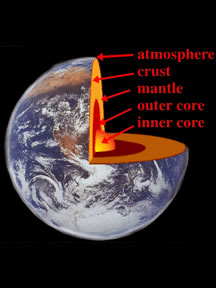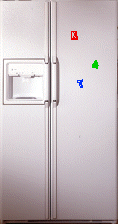Ocean waves off the coast of Mexico
Click on image for full size
copyright 2002 University Corporation for Atmospheric Research
What is a Fluid?
A fluid is anything that would spill or float away if it
weren't in a container (unless it's big enough to be held
together by gravity like a star). If you can stir it up with
a spoon or blow it through a straw, it's a fluid. Water is
a fluid and so is air. In fact, all liquids and gases are fluids.
In space and inside stars there's also another kind of fluid
called a
plasma.
The molecules
in a solid are stuck together, but in a fluid they're
free to move past each other. So if you had very small hands
you could push one molecule of a fluid one way and another molecule the other
way and off they would go in the direction you pushed them.
Much of the universe is made of fluid, including Earth's
atmosphere
and oceans,
giant planets like Jupiter,
stars like the Sun, and
huge clouds of
gas and dust in space. Even rock and metal can be fluid
if they're hot enough; that's what happens
deep inside the Earth.
Fluid dynamics (also called fluid mechanics) is the science of how fluid
moves around. A fluid in motion is called a flow.
You might also be interested in:

What types of instructional experiences help K-8 students learn science with understanding? What do science educators teachers, teacher leaders, science specialists, professional development staff, curriculum designers, school administrators need to know to create and support such experiences?
...more
Earth's ocean covers more than 70% of our planet's surface. There are five major ocean basins. The Pacific Ocean is the largest. It’s so large that it covers a third of the Earth's surface. The Atlantic
...more
Earth has a diameter of about 12,756 km (7,972 mi). The Earth's interior consists of rock and metal. It is made up of four main layers: 1) the inner core: a solid metal core made up of nickel and iron
...more
Liquid is one of the four common states of matter. The three others are gas, solid, and plasma. There are also some other exotic states of matter that have been discovered in recent years. A liquid does
...more
A fluid is anything that would spill or float away if it weren't in a container (unless it's big enough to be held together by gravity like a star). If you can stir it up with a spoon or blow it through
...more
When you "blow up" a balloon, you are raising the pressure on the inside of the balloon. That makes the rubber in the balloon stretch, and the balloon gets bigger. Pressure is an idea scientists use to
...more
Infrared (IR) radiation is a type of electromagnetic radiation. Infrared "light" has a longer wavelength than visible light. Red light has a longer wavelength than other colors of light, and infrared has
...more
Magnetism is one of the main forces of nature, like the force of gravity. Like gravity, which causes objects to be attracted to each other, magnetism causes magnetized objects to be attracted to each other.
...more














